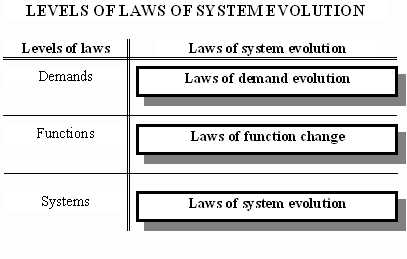
The Laws of System Evolution
Vladimir Petrov, ISRAEL. E-mail: AtrI@bigfoot.com
Abstract
This paper presents a system of the laws of technical system evolution.
1. INTRODUCTION
A research on developing the laws of technical evolution has been conducted by the author since 1973. Principal theoretical statements were formulated in 1984. As a foundation for the research, the laws of technical system evolution were selected which were originally developed by Genrich Altshuller, the creator of the Theory of Inventve Problem Solving. (1), (2).
In addition to Altshuller, the following researchers contributed to study and developments the laws of technical system evolution: B. Goldowsky; B. Zlotin and A. Zusmann; Yu. Salamatov and I. Kondrakov; S. Litvin and V. Guerassimov; I. Vertkin; G. Ivanov; V. Petrov and E. Zlotin; M. Rubin; V. Fey; A. Pinyaev; I. Zakharov; V. Dubrov; G. Frenklakh; G. Ezersky; A. Bystritsky
(5-40).Form our point of view, until now, no unified vision of the laws of technical system evolution was available. All the above-mentioned authors presented generic and specific aspects of the laws. There are several systems available which describe the laws of technical system evolution. In our opinion, most successful are the systems developed by G. Altshuller; B. Zlotin and A. Zusmann; and Yu. Salamatov.
This paper presents a system of laws, which, in the opinion of the author, makes it possible to perform forecasts of technology evolution more thoroughly and easier.
2. SYSTEM OF LAWS
2.1. General information
Evolution of all objects of the material world including technological objects are governed by certain laws. Among the most general laws are the laws of dialectics (the law of the unity (interpenetration) of opposites; the law of transformation of quantity into quality; and the law of the negation of the negation).
A system of the laws of technical system evolution must have three levels: demands, functions and systems.
A hierarchy of the system of laws developed by the authors is presented in Figure 1.

Figure 1.
The laws of system evolution can be divided to two groups:
Laws of system organization (those which define viability of a system) and
Laws of system evolution (those which define how technical systems evolve).
2.2. Laws of dialectics in technology evolution.
Most general laws of the laws of dialectics are:
The Law of the Unity (Interpenetration) of Opposites;
The Law of Transformation of Quantity into Quality;
The Law of the Negation of the Negation
The Law of the Unity (Interpenetration) of Opposites serves as a source for creation of all objects including material objects, where technical systems belong. The law defines one of the key TRIZ concepts: contradiction.
The Law of Transformation of Quantity into Quality defines a general mechanism of evolution. Quantitative changes in a system take place continuously accordingly the S-curve of evolution. When a certain limit of quantitative evolution is reached, a system experiences qualitative changes. Further evolution of the system starts according to a new S-curve. During this process, quantitative changes take place continuously whereas qualitative changes take place in discrete steps.
To imagine a full diagram of evolution of technical systems, it is necessary to take into account a so-called “line of life of a technical system”, a regularity defined by Genrich Altshuller (1, pp. 113-119).
An essence of the Law of the Negation of the Negation is that a process of progressive evolution consists of a series of relative repetitions, as if going through the same phases again and again. However, each repetition takes place at a higher level of evolution by using new elements, materials, and technologies. We can say, that in this case we have a spiral-shaped evolution. For example, fashion design is the most obvious example of spiral-shaped evolution.
2.3. Regularities of demand evolution
Knowing regularities of DEMAND evolution makes it possible to predict future demands. This, in turn, allows us to define what functions and systems will be needed to meet these new demands. This knowledge also makes it possible to discover radically new directions of technical system evolution (pioneering solutions).
The regularities of demand evolution are governed by the law of demand growth. A general trend of demand evolution states that meeting of demands evolves from meeting primitive demands to meeting intelligent and creative demands.
The regularities of demand evolution separate along the two directions: appearance of new demands and evolution of existing demands.
The demands can be met by available and new functions. Changing of these functions, in turn, is governed by certain regularities as well.
Known functions can be delivered by the available systems or by creation of new systems.
New functions can be delivered by using the existing systems in a new context or by creating qualitatively new systems.
Among the laws of demand evolution are: idealization of demands, growths of dynamics of demands, coordination of demands, merging or specialization of demands.
Development of new demands is conducted in accord with a technique proposed by the author (5).
2.4. Regularities of function evolution
Let us study some regularities of FUNCTION evolution, for instance, poly-functionality and mono-functionality.
At the beginning of evolution, systems are created as poly-functional, or universal. At the final stage of evolution systems become more specific, and further evolve by separation of evolution of specific functions. As a result, the systems become mono-functional.
Regularities of poly- and mono-functionality are based on the mechanisms of expansion and convolution of functions.
The laws of function evolution are similar to the laws of demand evolution, however they should be regarded with respect to functionality: making functions more ideal (idealization of functions); growth of the degree of function dynamics; coordination of functions; transition to mono or poly-functionality.
Idealization of functions is achieved by increasing the degree of function dynamics, then by transition to mono- or poly-functionality and by further coordination of functions.
Regularities of expansion and convolution of functions are presented by the author in (11,12).
3. THE LAWS OF SYSTEM ORGANIZATION
This group of laws governs a newly created system.
The laws of system organization define criteria of vitality for newly created technical systems
Among the main laws of the laws of system organization are: systemity; completeness of system parts; abundance of system parts; existence of links between system parts as well as between the system and its supersystem; minimal coordination of parts and parameters of a system.
A structure of the main laws of system organization is presented in Figure 2.

Figure 2
3.1. The law of systemity
Systemity is a coordinated interaction between all objects, including environment where the objects are located. This interaction must be fully balanced.
System requirements:
A system must be designated to meet a certain purpose.
A system must possess a certain structure, which provides the achievement of the purpose.
Relationships and interactions
Regularities of evolution
A system meets its purpose if the system achieves a general goal and delivers all required principal and auxiliary functions.
A system structure consists of the system itself, its subsystems, supersystem and environment.
A systemity is taken into account by using the following laws:
Completeness and abundance of a system.
Minimal coordination (ensuring desired relationships and interferences).
3.2. The law of system completeness
The system completeness can be functional and structural.
Functional completeness must ensure delivery of a general goal of the system and correspond to the functional purpose of the system, and in the first place, to the main function of the system. This means that all principal and auxiliary functions must be fulfilled as well.
Structural completeness of the system must provide presence of all required elements and links in the system.
A main function of the system is provided by a main working unit of the system. Energy supply and control are the principal functions of the system. These functions are provided by an energy source and a system comprising a control unit. Most important among auxiliary functions are conversion and transport of energy and information.
As a conclusion, the law of system completeness describes the least but necessary set of system parts that provide minimal working behavior of the system. In general, the following parts are necessary:
Working unit.
Energy source and converter.
A system of control (control unit).
Energy transformation can be provided, for instance, by an engine whereas energy and information transport can be provided by transmission (links).
Also, a general case requires the following system parts: the working unit; energy to provide the working tool; and a system for control over the working unit.
3.3. The law of abundance
ABUNDANCE is a regularity which indicates that about 80% of work is delivered by approximately 20% of functions, elements and links in a system. When developing a system it is necessary to take into account, that in order to deliver the required work approximately 80% of auxiliary elements and links will be needed in addition to those main elements and links that are supposed to deliver a main function. These auxiliary elements and links will provide 20% of the work only. This results in the necessity to consider some extra consumption of material, energy and information when designing a new system (approximately 20% to deliver main function and 80% to deliver auxiliary functions).
The same ratio is valid for execution of any type of work. A major volume of work (80-90% of readiness) is fulfilled during 20% of time; and remaining 80% of time is required to finish the work completely.
Due to this, often the work is not fully completed.
Abundance can be functional and structural.
3.4. The law of existence of links.
This law was first formulated by G. Altshuller in the beginning of the 70’s as the law of energy conductivity in a system (1).
The law of Altshuller is a particular case of the law of links, which was formulated by the author in the end of the 70’s.
Without considering all possible links and influences a system can not be well-behaved. Moreover, the system can create ecological and other problems, negatively changing the environment, supersystem, human health, neighboring systems and so on.
Links (interrelations) and influences (interferences) can be of the following types:
|
1. 1. By level |
3.5. Chemical |
|
1.1. Between subsystems |
3.6. Biological |
|
1.2. Between system and subsystems |
4. By remoteness |
|
1.3. Between systems |
4.1. Direct |
|
1.4. Between system and supersystem |
4.2. Remote |
|
1.5. Between system and environment |
5. By type of control |
|
2. By quality |
5.1. Controllable |
|
2.1. Material |
5.2. Non-controllable |
|
2.2. Energy |
6. By type of interaction |
|
2.3. Informational |
6.1. Planned |
|
3. By type of interaction (field) |
6.2. Accidental |
|
3.1. Gravitational |
7. By type of action |
|
3.2. Mechanical |
7.1. Necessary or desired |
|
3.3. Thermal |
7.2. Non-necessary or non-desired |
|
3.4. Electromagnetic |
7.3. Indifferent. |
Formulation and recognition of links is conducted with the use of special tables and in a sequence, which were developed by the author.
3.5. The law of coordination
A group of laws of technical system organization introduces minimal coordination which is needed to provide a minimal working behavior of a system. A minimal coordination is required to avoid negative interference between system parts.
Minimal coordination can be achieved at the levels of functions, structure and matching the structure and the functions. Coordination can be functional, structural and function-structural.
4. LAWS OF TECHNICAL SYSTEM EVOLUTION
4.1. A structure of laws of evolution
The laws of evolution define a general direction of technical system evolution. A structure of these laws is shown in Figure 3.
Main laws of technical system evolution are:
Increase the degree of ideality.
Irregular evolution of system parts.
Increase the degree of system dynamics.
Coordination.
Transition of a system to a supersystem.
4.2. The law of increase of the degree of ideality
A general direction of technology evolution is defined by the law of increasing the degree of ideality of technical systems. (Fig. 3).
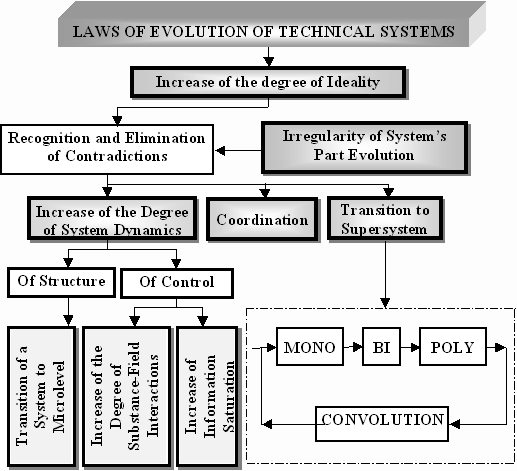
Figure 3
In turn, the general direction of making a system more ideal is defined by the laws of Increase of the degree of system dynamics; Coordination; and Transition of a system to a supersystem.
An Absolutely Ideal System (which is impossible) is defined as a system which does not exist but all possible functions are delivered at the required moment of time in the required space with 100% of effectiveness, whereas there is no consumption of power, material, energy and information. Therefore, Absolutely Ideal System must deliver an infinite number of functions, at the required moment of time and in the required space without producing negative effects and the required expenses do not exist. The use of information is not regarded as expenses in the case where information is available for free. A more ideal system always uses more free of charge information.
A degree of ideality can be expressed as:
|
|
Where: |
I - the degree of ideality; F - a function delivered of a positive effect; P - negative effect, expenses; i - a number of variable F; j - a number of variable P. |
|
(*This formulae (in more simplified form) was first proposed by Boris Goldovsky in 1974.) |
||
Directions and paths of increasing the degree of ideality
There are two directions of increasing the degree of ideality:
1.1. Shrinking of a zone of a given technical system: ideal technical system - working unit - function, which is delivered by the working unit. In this case, the system approaches zero.
1.2. Expansion of a zone of consideration of a technical system: we consider a function of the system, a function of a supersystem and, finally, a demand. In this direction it is possible to consider alternative methods of meeting the recognized demand. In this way new solution principles can be suggested.
Methods of Idealization
2.1. Reduction of some parts of a system or a process.
2.2. Increase of a number of delivered functions
2.3. Increase of specific parameters.
2.4. Using advanced equipment, materials, processes.
2.5. Elimination of undesired effects .
2.6. Using of disposable objects.
2.7. Using block-structured designs.
2.8. Using expensive materials in necessary zones only.
2.9. Using resources.
The use of the laws of system idealization
These methods of idealization will be presented by the laws of Increase of the degree of system dynamics; Coordination; and Transition of a system to a supersystem.
4.3. The law of coordination of structure
4.3.1. Structure of the law of coordination
Coordination is conducted to avoid harmful effects or to amplify useful effects. A structure of the law of coordination:
1. Coordination can be:
1.1. Static
1.2. Dynamic
Coordination is conduced by the levels of:
2.1. Demands
2.2. Functions
2.3. System.
Types of coordination:
3.1. In time,
3.2. In space,
3.3. of structure,
3.4. by conditions,
3.5. of parameters.
The law of coordination is a general law of system evolution. It includes:
Coordination of systems
- Coordination of subsystems
- Coordination of supersystems
- Coordination of external environment
When coordinating a system, first its structure should be coordinated. By structure we will understand form, location and interaction of separate elements.
A structure of a system is defined by its elements and links. They can be:
Material
Energetic
Informational
System terms of a structure, its elements and links, as well as their types (material, energy, information) are valid for subsystems, supersystem and external environment.
Parameters can be:
Technical
Ergonomic
Economic
Ecological
Esthetic
Social
Political
Etc.
Specific regularities of coordination of structure are available. For instance, elements and materials, shapes, links, parameters (in particular, their rhythms)
4.4. The law of increase of the degree of system dynamics
A structural diagram of the law is shown in Figure 4.
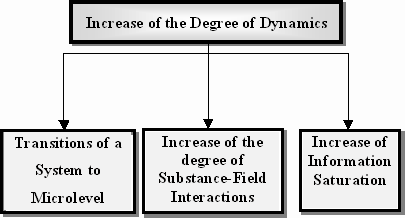
Figure 4
The law of increasing the degree of dynamics includes the following sub-laws:
A law of transition of a system structure from macro- to microlevel.
§
§
§
4.5. The law of transition of a system structure from macro- to microlevel
The law of transition of a system structure from macro- to microlevel includes the following sub-laws:
Changes of a scale.
Changes of linking.
Transition to more complex and energy-saturated forms.
4.5.1. Change of a scale of a technical system
A scale of a technical system is changed by transition from supersystem to a system, from the system to its subsystem and substance (see Figure 5). The ultimate goal is transition from the supersystem to substance (that is, replacing a system with a substance).
4.5.2. Change of system linking
Change of a degree of the system linking is provided by increasing the degree of fragmentation (dispersibility) of a substance. In particular, it can be done by using capillaries-porous materials and increasing the degree of void in a substance (Figure 6).
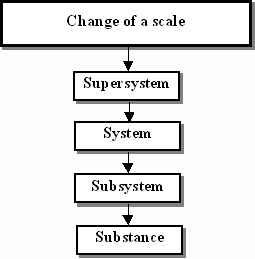
Figure 5
4.5.2.1. Increase of the degree of fragmentation
In addition to the above mentioned, the increase of the degree of fragmentation (dispersibility) of substances involves change of hardness and plasticity of a material. First of all, the working unit undergoes the changes.
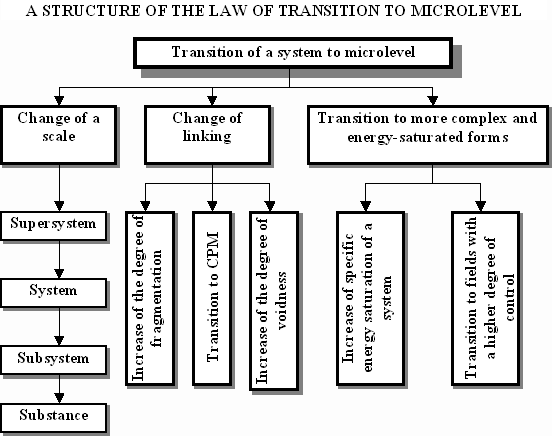
Figure 6

Figure 7
The working unit (tool) can be monolithic or non-monolithic (consisting of several parts). A material of the tool can be hard, non-hard (soft), liquid, gaseous or a physical field.
This sequence is featured by the transition from solid monolithic system (1) to entirely flexible (elastic) object (2); to an object consisting of powder (3), to gel (4), to liquid (5), to aerosol (6), to gas (7), and finally, to a field (8). In particular, it can be plasma.
In addition, any combination of mentioned states are possible. To raise the effectiveness of operation, technological effects applicable to any given state can be used.
A complete diagram presenting the regularity is more complex. It includes additional transitions from the state (1) to state (2), from (2) to (3) and transitions from states (1) and (2) to capillaries-porous materials (CPM).
4.5.2.2. Transition to capillaries-porous materials
Transition from monolithic object (solid or soft) to separate parts can be done according to a sequence presented by G. Altshuller in Inventive Standard 2.2.3 which he called “transition to capillaries-porous materials”.
Let us show this regularity in more detail.
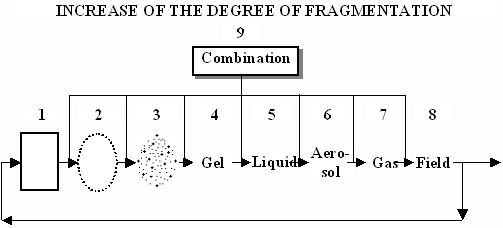
First, we describe major phases introduced by the regularity (Fig. 8), and afterwards we show more specific transitions (Fig. 9).
Figure 8
Figure 8 presents the regularity of transition to capillaries-porous materials (CPM):
Solid substance, hard
Solid substance with a single cavity:
Solid substance with many cavities (cells):
Capillaries-porous materials: CPM
Capillaries-porous materials (CPM) at microlevel
Transitions from (A) to (B), from (B) к (C) and from (C) to (D) are similar and are governed by the following regularity of using cavities: 1) cavity - 2) a cavity with a structure (a cavity which has a certain structure), - 3) cavity filled with substance - 4) civility filled with a substance which can be controlled by fields with the use of various technological effects (Figure 9)

Figure 9
More detailed sequence is a combination of the sequences presented above.
A particular case of the line of fragmentation is a line of increasing “voidness” developed by G. Altshuller (4).
4.6. Transition to more complex and energy- saturated forms of motion
Let us examine the transition to more complex and energy-saturated forms of motion, which first of all, relate to the working unit.
As shown in Fig. 6, such transition is realized by increasing a specific saturation of energy in a system and transition to the fields that have a higher degree of control (see Fig. 10).

Figure 10
4.6.1. Increase of a specific energy saturation.
Increase of specific energy saturation of the working unit makes it possible not only to raise effectiveness and quality of manufacturing processes but also to create new manufacturing processes.
4.6.2. Transition to field with higher degree of control
Increase of a degree of control over fields takes place in two directions:
Replacement of a field (Fig. 11)
for fields (Fig. 12). Transition MONO-BI-POLY
4.6.2.1. Replacement of a field type
Replacement of a field type with a field that has a higher degree of control can be done in the following order: gravitational, thermal, mechanical, electromagnetic, chemical, biologic. Combination of these fields is possible. This regularity is shown in Fig.11. Let us describe the trends of change of the most frequently used fields in technical systems.

Figure 11

Figure 11a

Figure 11b
4.6.2.2. Transition of a field to Mono-Bi-Poly
Efficiency of a working unit can be increased by the use of a combination of fields according to the Mono-Bi-Poly diagram (Fig. 12).
Dynamics of evolution of the working unit indicates that in the beginning of the evolution process, the use of fields is limited to a single field (F1), and further its type is changed according to the regularity mentioned above (Fig. 11).
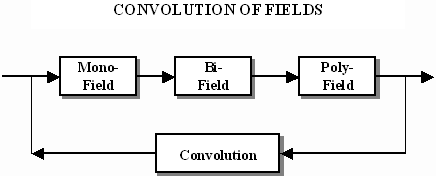
Figure 12
During the next phase of evolution, another field is added to the existing one. As a result, we observe a transition from MONO-field to Bi-field. Combination of the fields of the same physical type or of different types is possible. The fields of the same type can be identical (F1 + F1) or have dissimilar characteristics (F1 + F1’).
Similarly to combining systems, further evolution is featured by the coordination of the fields used in a system. For instance, (F1 + F1~) is a coordination of permanent field F1 with a variable Field F1~. Later, the fields can be replaced with a single field (MONO-field, F0). This is process is known as convolution.
The next transition can use more than two fields thus forming a POLY-system of fields (Fig. 13).
![]()
Figure 13
4.7. The law of increasing the degree of control over a system.
Rising the degree of dynamics of control is known as the law of increasing the degree of control over a system. Rising the degree of dynamics of control results from increasing the degree of substance-field interactions in a system and increasing information saturation in a system.
4.7.1. The law of increasing the degree of substance-field interactions in a system
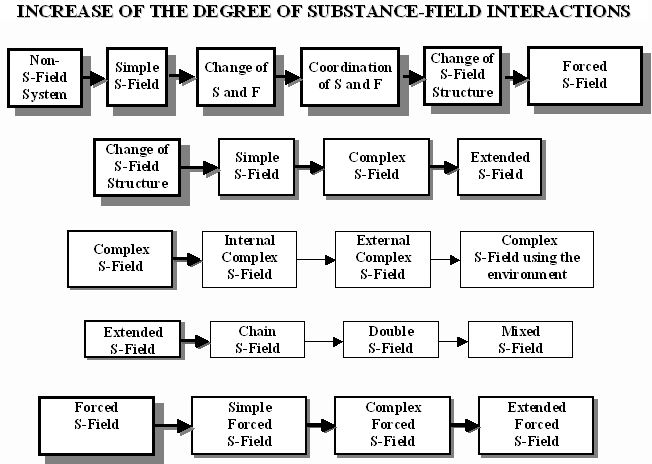
Figure 14
4.7.2. The law of increasing information saturation in a system
The law of increasing information saturation in a system means decreasing the degree of human involvement to the work provided by a technical system. This results in the use of automated systems, self-evolution and self-reproduction (Fig. 15). Modern trends indicate that material objects are replaced with software..
The raise of the degree of control over a system results from transition from non-controllable system to the control over deviances, then to the system with feedback, to adaptive system, to self-educational and self-organizational system, and, finally, to self-evolving and self-reproducing system. The rising the degree of dynamics of control describes the process of automation.
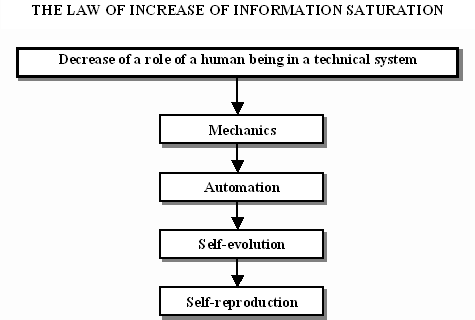
Figure 15
4.8. The law of transition to supersystem.
4.8.1. General Information
The law of transition to supersystem was developed by G. Altshuller (2), and is presented as a transition mono-bi-poly (Fig. 16).
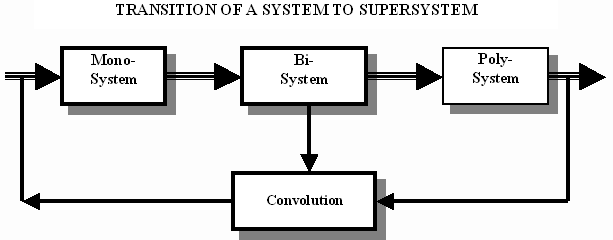
Figure 16
4.9. General direction of system evolution
As a rule, general evolution of systems is not limited to any single law, but takes place in a combined form. Apart from that, evolution takes place in space as well: from a single dot to a line, from the line to a plane, from the plane to volume. This trend is shown in Fig. 17.
Transition from the line to the plane and volume can be done by the use of curves in the plane and space (see Fig. 17a).
Transition from the plane to the volume: the use of a backside of a plane. In particular, it can be achieved by using the Mobius tape (see Fig. 17b).
Internal areas can be used in the volume (the “nested doll” principle). In particular, this can be Kisilyov tape (similarly to the Mobius tape, but in volume). This trend is shown in Fig. 17c. Other geometric effects can be used as well.
Finally, pseudo-volumes can be used. For instance, stereoscopic images, holograms, and 3D imaging in computer systems.
Further idealization of a system is achieved through the use of resources.

Figure 17
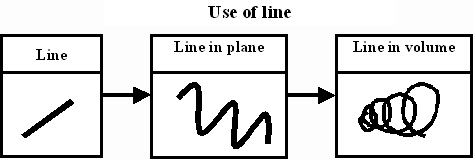
Figure 17a

Figure 17b

Figure 17c
5. TECHNICAL SYSTEM FORECAST WITH THE USE OF TRIZ
The tasks of forecast of technical system evolution is a task of search which is conducted with the use of the system of Inventive Standards and Laws of Technical System Evolution. The process of the forecast is organized by using a special technology of forecast which includes the technology of information processing.
References
All references are in Russian
Altshuller G.S., ‘Creativity As an Exact Science. Theory of Inventive Problems Solving’, (Moscow, Sovetskoye Radio, 1979).
Altshuller G.S., ‘To Find an Idea: Introduction to the Theory of Inventive Problems Solving’, (Novosibirsk, Nauka, 1986)
Altshuller G.S & Vertkin I., ‘Lines of Voidness Increase’, (Baku, 1987, Manuscript).
Altshuller G.S., ‘Small Infinite Worlds: Standards For Solving Inventive Problems’, in ‘A Thread in a Labyrinth’, Karelia, 1988, pp 183-185.
Petrov V.M., ‘A System Analysis for Selection of Technical Problems’, in ‘Methods of Design problem Solving’, Riga, pp.73-75.
Zukov R.F. & Petrov V.M., ‘Modern Methods of Scientific and Technological Creativity’, (IPK SP, 1980).
Petrov V.M., ‘Idealization of Technical Systems’. Presented at the conference ‘Problems of Developing Scientific and Technological Creativity of R&D personnel, Gorky, USSR, 1983, pp.60-62.
Petrov V.M., ‘Regularities of Technical Systems Evolution’, Presented at the Conference ‘Methodology and methods for Technical Creativity’, June 30 - July 2, 1984, Novosibirsk, p. 52-54.
Petrov V.M., ‘A Technique for Selecting Perspective Directions of Research and Development’,. (Leningrad, VNIIESO, 1985).
Petrov V.M., 'Principles and Methodology for Selecting Perspective Directions of Research and Development in ship manufacturing’ Ph.D. Thesis, LKI, 1985.
Petrov V.M., ‘Functional Structure of Informational Base for Predicting Scientific and Technological Progress’, In ‘Forecast of Progress and its Impact on Reducing the Cycle “Research - Manufacturing”, LDNTP, 1987, pp.35-38.
Petrov V.M., ‘A Technology of Using Resources’, In ‘Theory and Practice of Technical Creativity Education’, Tchelyabinsk, 1988.
Petrov V.M. & Zlotina E.S., ‘Theory of Inventive Problem Solving: A Basis for Technological Forecast’, (Methodical Developments, Leningrad, CNTTM Kvant, Bratislava: DT CCNTO, 1989).
Petrov V.M. & Zlotina E.S., 'Theory of Inventive Problem Solving’ Course book, (Leningrad, 1990).
Petrov V.M. & Zlotina E.S., ‘Laws of System Evolution”, (Leningrad, 1990).
Petrov V.M. & Zlotina E.S., ‘Increase of the degree of Substance Fragmentation’, (Tel-Aviv, 1991).
Petrov V.M. & Zlotina E.S., ‘Laws of System Evolution”, (Tel-Aviv, 1992).
Zlotina E.S & Petrov V.M., ‘A Structure and Principal Concepts of the Theory of Inventive Problem Solving’, (Tel-Aviv, 1992).
Petrov V.M. & Zlotina E.S., ‘Structural Substance-Field Analysis’, A Coursebook, (Tel-Aviv, 1992).
Altshuller G.S, Zlotin B.L., Zusman A.V. & Philatov V.I., ‘Search For New Ideas: From Insight to Technology. A Practice of inventive Problem Solving’, (Kishinev, Karte Molavenjaske, 1989).
Proceedings of the Scientic-Practical Conference, June 30 - July 2, 1984, Novosibirsk, pp 70-72.
Guerassimov V.M & Litvin S.S., ‘Taking into Account the Trends of Technology Evolution During Value Engineering Analysis of Manufacturing Processes’, in ‘Practice of Performing Value Engineering Analysis in Electroengineering Industry’. M.G. Karpunin, ed., Moscow, Energoatomizdat, 1987, pp. 193-210.
Guerassimov V.M & Litvin S.S., ‘Why the Technology Needs Pluralism’, Journal of TRIZ, 1, 1/90, pp.11-25.
Ivanov G.I., ‘And Start to Invent’, (Irkutsk, Vostocho-Sibirskoe Kn. Izdatelstvo, 1987), pp. 187-190.
Fey V.R. ‘In search of an ideal Substance’, Journal of TRIZ, 1/90, pp. 31-40.
Frenklah G.B. & Ezersky G.A., ‘About Some Regularities of Sypersystem Transitions’, Journal of TRIZ, 1, 1/90, pp. 25-29.
Zakharov I.S., ‘TRIZ and Marxism: An Experience With Predicting Crises of a Theory’, Journal of TRIZ, 3, 1/92 (5), pp. 13-23.
Guerassimov V.M & Litvin S.S., ‘Basic Statements of the Technique for Performing VEA. Convolution and Super-effect’. Journal of TRIZ, 3, 2/92, pp. 7-45.
Dubrov V.E., ‘A Method For Searching For Super-effects’, Journal of TRIZ, 3, 2/92, pp. 46-50.
Mitrofanov V.V., ‘Several Thoughts About Ideality’, Journal of TRIZ, Angarsk Version, 1993 (Electronic Edition), pp. 45-47.
Ivanov G.I., ‘The Law of Through Energy Transport’, Journal of TRIZ, Angarsk Version, 1993 (Electronic Edition), pp. 48-52.
Bystritsky A.A., ‘Systematics of Technical System and Technical Models’, Journal of TRIZ, Angarsk Version, 1993 (Electronic Edition), pp. 35-36.
Zlotin B.L. & Zusman A.V. ‘General Laws of Evolution’, Journal of TRIZ, 1/94, pp. 24-28.
Zakharov A.N., ‘Towards Developing a System of Laws of Technology Evolution’, Journal of TRIZ, 1/95, (№ 10), pp. 19-29.
Pinyaev A.M., ‘Union Under the Function Sign (A functional Approach to Amalgamation of Alternative Systems). Jour
Zakharov A.N., ‘A Hierarchy of Systems: Upwards the stairs leading up’, Journal of TRIZ, 1/96, (№ 11), pp. 34-39.
Zakharov A.N., ‘About Unity of TRIZ Tools”, Technology of Creativity, №1, 1999, pp. 19-38.
Salamatov Yu.P., ‘A System of Laws of Technology Evolution (Basics of The Theory of Technical System Evolution’, http://www.triz.minsk.by/e/21101300.htm, (Second Edition, Krasnoyarsk, INSTITUTE OF INNOVATIVE DESIGN, 1996).
Rubin M.S. ‘Methods of Prediction on the basis of TRIZ’, http://www.trizminsk.org/e/216002.htm.
About the author
Vladimir Petrov, TRIZ Master, Board Member of International TRIZ
Association, Scientific consultant of ETRIA, President of the TRIZ Association
of Israel (ATI) and President of P.V.F. Solutions (TRIZ consulting company) has
30 years of experience in TRIZ and widely recognize as one of the foremost TRIZ
theorists, scientists, and problem solvers in the world today. He was one of the
first followers and lecture college of Genrich Altshuller, the founder of TRIZ.
V. Petrov organized the TRIZ scientific schools of inventive problem solvers in
USSR, Czech, Bulgaria Vietnam and Israel and raised more then 6000 students
worldwide. He also solved more then 5000 technical and engineering problems for
different companies in USA, Germany and Israel.
Copyright © 2002 by Vladimir Petrov
|
©
Copyright 1997-2005 CTQ Media LLC |